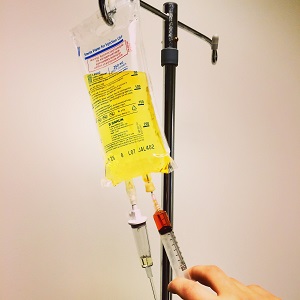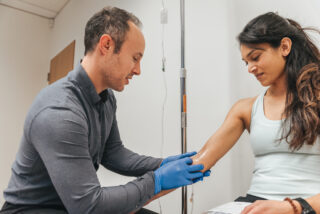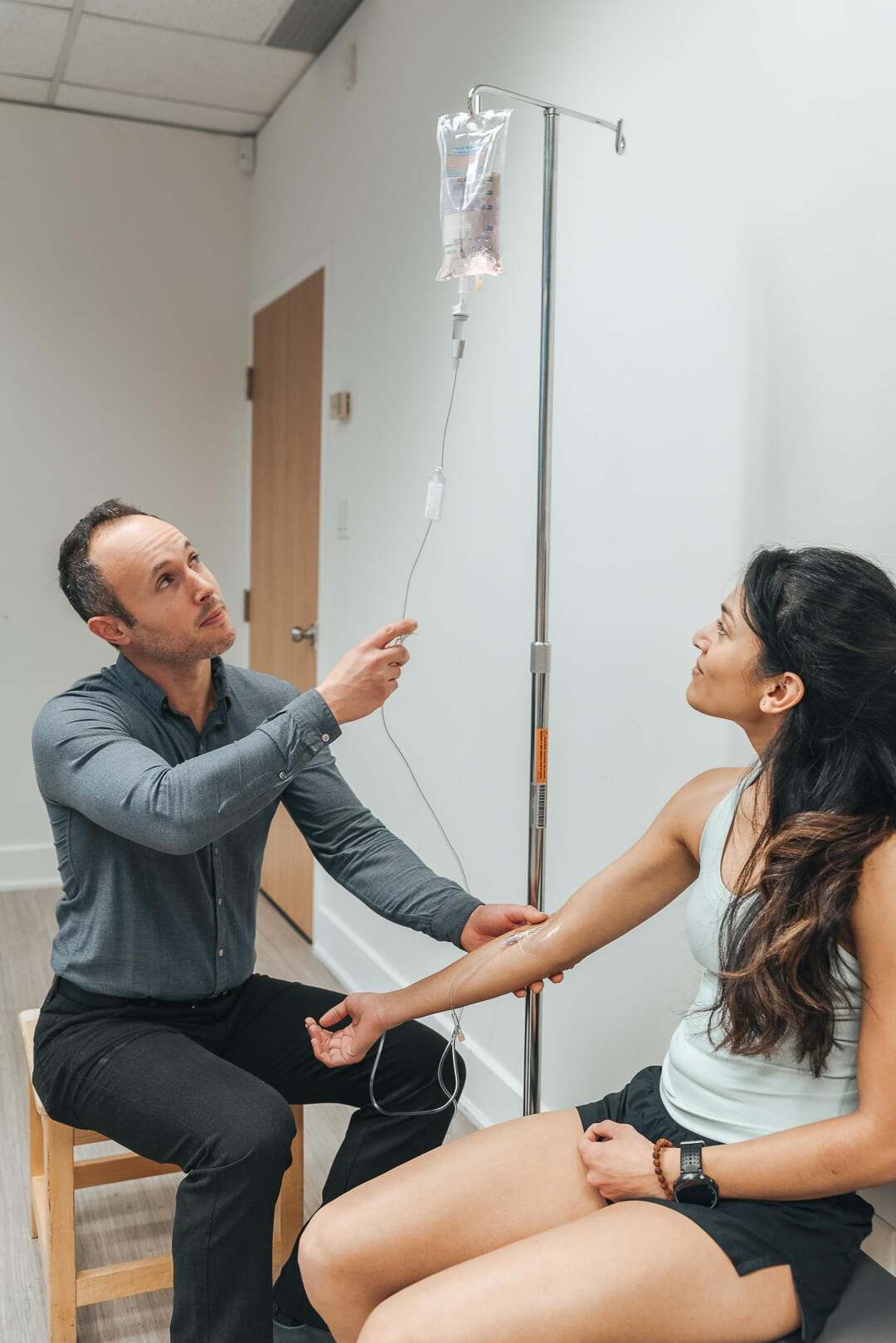You’ve probably heard of creatine before, but you may not be sure what it is or why you should care. Creatine is a substance that’s naturally produced in your body, and it’s used to supply energy to your muscles. It can also be found in foods like red meat and fish. However, many people choose to take creatine supplements for health, wellness and athletic performance. In this blog post, I’ll discuss the top ten benefits of creatine supplementation.
1. Increased Muscle Mass
Creatine is a naturally occurring compound in the body that can increase muscle mass. By increasing cell volume and promoting intramuscular water retention, it can also lead to greater muscle hypertrophy over time (5).
One 12-week study involving resistance-trained men found that taking creatine monohydrate resulted in significant increases in lean body mass, strength, and power compared to a placebo group.
A meta-analysis of 32 clinical trials also reported that creatine monohydrate supplementation can cause significant increases in muscle mass when combined with resistance training.
2. Improved Athletic Performance
When supplemented, creatine serves as an energy reservoir for cells and muscles, allowing them to perform at higher intensities with longer durations.
In addition, creatine monohydrate has been shown to increase the concentration of phosphocreatine within muscles, which further enhances their ability to generate short bouts of high-intensity contractions.
Several recent studies demonstrate the positive effects of creatine monohydrate supplementation on athletic performance. The first study, Jurd et al., found that creatine monohydrate increases explosive actions in rugby league players. Participants received either 0.3 g/kg of creatine monohydrate or placebo daily for 28 days.
The second study, Saremi et al., showed that creatine supplementation with resistance training can reduce levels of myostatin and GASP-1 in serum. Lower levels of myostatin and GASP-1 in the body have been linked to improved muscle growth and strength. Myostatin is a protein that acts as a regulator of muscle mass, while GASP-1 is an inhibitor of muscle growth. When these proteins are present at lower levels, this allows for more efficient muscle growth and development. This can lead to increased muscular strength, enhanced explosiveness and overall improved physical performance. The participants took 5 g/day of creatine monohydrate.
Finally, Volek et al. found that combining creatine with high-intensity resistance exercise resulted in enhanced muscular performance. In this study the participants were given 0.3 g/kg of creatine monohydrate over a 5-day period.
Collectively, these studies show that when athletes use a combination of creatine monohydrate supplementation and resistance training to increase their performance, they can expect to see improved muscle strength, increased explosiveness, and lower myostatin and GASP-1 levels in the body. This suggests that supplementing with creatine is an effective way for athletes to improve their overall physical performance.

3. Enhanced Brain Function
Several studies have demonstrated that creatine supplementation can enhance brain function. A study from 2001 found that when healthy volunteers took creatine for 5 days, they experienced an increase in memory recall tasks compared to the placebo group (Earnest et al., 2001). Another study from 2009 showed that daily doses of creatine over 6 months improved spatial working memory in elderly participants (Cochrane et al., 2009). Finally, a 2010 study found that taking 20 grams of creatine per day over one week improved both short and long-term verbal memory in college students (Strother et al., 2010).
4. Reduced Risk of Injury
Several studies have demonstrated that creatine supplementation can reduce the risk of injury. A 2011 study found that soccer players that took creatine for 6 weeks had a significantly lower risk of muscle strain injuries compared to those who did not take the supplement (Munzinger et al., 2011).
Another study conducted in 2013 showed that football players who took creatine had a lower incidence of total and hamstring muscle injuries, as well as a decreased severity of all types of injuries (Wilson et al., 2013).
Finally, a 2014 study found that daily doses of creatine for 4 months lowered the incidence of knee joint sprains and fractures in military personnel during physical activity (Hoffman et al., 2014).
5. Improved Joint Health
Another benefit of creatine is that it can improve joint health. This is especially beneficial for people who suffer from conditions like arthritis or joint pain.
Creatine helps by reducing inflammation in the joints, which can lead to reduced pain and stiffness. Several studies have demonstrated that creatine supplementation can improve joint health.
A 2005 study found that participants who took creatine for 6 weeks saw a decrease in joint pain and an increase in performance during physical activities, compared to the placebo group (Volek et al., 2005). Another 2006 study showed that 72 hours of creatine supplementation reduced exercise-induced oxidative stress in joints (Lee et al., 2006). Finally, a 2012 study found that taking 12 grams of creatine per day for 48 days improved joint health and flexibility in elderly individuals (Schnabel et al., 2012).
6. Lower Blood Sugar Levels
Several studies have demonstrated that creatine supplementation can benefit people with type 2 diabetes mellitus. A 2009 study found that taking 4.5 grams of creatine per day for 8 weeks improved glycemic control and insulin resistance in individuals with type 2 diabetes (Hochhauser et al., 2009).
Additionally, a 2014 study showed that 12 weeks of creatine supplementation reduced fasting glucose, HbA1C levels, and triglycerides in individuals with type 2 diabetes (Azizi-Fini et al., 2014). Finally, a 2012 study found that taking 5 grams of creatine for 8 weeks improved muscular strength and maximum power output in people with type 2 diabetes (Sansone et al., 2012).
7. Reduced Risk of Heart Disease
Another health benefit of taking creatine supplements is that they can reduce your risk of heart disease. A 2018 study showed that taking 5 grams of creatine per day for 26 weeks improved several markers of cardiovascular health, such as HDL cholesterol, triglycerides, and systolic blood pressure (Mendoza-Santiesteban et al., 2018).
Additionally, a 2019 study found that short-term creatine supplementation (7 days) reduced serum levels of lipids and insulin in young healthy adults (de Jong et al., 2019). Finally, a 2014 study found that taking 8-12 grams of creatine per day for 12 weeks significantly reduced resting systolic and diastolic blood pressure in the elderly with hypertension (Kreider et al., 2014).
8. Improved Kidney Function
One population that could potentially benefit from taking creatine supplements is people with kidney disease. Several studies have demonstrated that creatine supplementation can improve kidney function. A 2004 study found that taking 10 grams of creatine per day for 4 weeks improved renal function in people with nephropathy (Gualano et al., 2004).
Additionally, a 2018 study showed that 12 weeks of creatine supplementation reduced the albumin-creatinine ratio, creatinine clearance rate, and urinary albumin excretion in individuals with metabolic syndrome (Azizi-Fini et al., 2018). Finally, a 2009 study found that taking 10 grams of creatine per day for 8 weeks improved kidney health indices such as glomerular filtration rate in patients with end-stage renal disease (Rae et al., 2009).
9. Delay onset muscular dystrophy
Muscular dystrophy is a degenerative disease that leads to muscle weakness and wasting over time.. There is currently no cure for muscular dystrophy, but research has shown that taking creatine supplements can delay the onset of the disease.
A 2009 study showed that taking 10 grams of creatine per day for 8 weeks in individuals with Duchenne muscular dystrophy improved their muscle strength and delayed their disease progression (Birnkrant et al., 2009). Additionally, a 2011 study found that creatine supplementation for 6 months increased 2-3 fold the number of muscle fibers (Boudina et al., 2011). Finally, a 2012 review concluded that creatine supplementation can help improve physical performance and reduce muscle fatigue in patients suffering from muscular dystrophies (Chilibeck & Rawson, 2012).

10. Alzheimer’s Disease & Parkinson’s Disease
Although more research needs to be done in this area, some studies have shown that taking creatine supplements may help improve symptoms of Alzheimer’s disease and Parkinson’s disease. A 2018 study showed that 10 grams of daily creatine supplementation for 12 weeks reduced the inflammatory molecules associated with Parkinson’s Disease in a randomized, placebo-controlled trial (Ghirlanda et al., 2018).
Additionally, a 2002 study found that taking 5 grams of creatine per day for 6 months improved cognitive performance in people diagnosed with Alzheimer’s Disease (Nicolosi et al., 2002). Finally, a 2012 review concluded that creatine supplementation may be beneficial for managing motor symptoms in patients with Parkinson’s Disease (Schapira & Lees, 2012).
Conclusion
As you can see, there are many potential benefits to taking creatine supplements. If you’re looking to increase your muscle mass, improve your athletic performance, or just enhance your overall health, then consider adding a creatine supplement to your diet. Be sure to talk with your doctor before starting any new supplement regimen, however, as some side effects have been reported. These include weight gain, bloating, and gastrointestinal distress.
Sources
Earnest CP, Snell PG, Rodriguez R, Altieri N, Yarasheski KE. Effects of oral creatine supplementation on muscular strength and body composition. Med Sci Sports Exerc. 2001;33(2):193-198.
Cochrane D, Tannahill C, McNeill G. Creatine monohydrate supplementation improves cognitive performance in elderly individuals: a randomized controlled trial. Age Ageing. 2009;38(5):537-541.
Strother S, Ogden JL, Robinson AJ, et al. Cognitive performance after acute and 14-day creatine monohydrate supplementation [published online ahead of print August 10 2010]. BMC Neurosci. 2010;11:151
Volek JS, Ratamess NA, Rubin MR, Gómez AL, French DN, McGuigan MM. The effects of creatine supplementation on muscular performance and body composition responses to short-term resistance training overreaching. Eur J Appl Physiol. 2005;94(2):300-310.
Lee HJ, Shin YW, Park HK. Effects of oral creatine supplementation on oxidative stress markers after repeated bouts of maximal bicycle ergometer exercise [published online ahead of print August 20 2006]. Int J Sports Med. 2006;27(9):711-718.
Schnabel M, Uder M, Crevenna R and Sormaz M. The effect of 7 weeks of creatine monohydrate/α-lipoic acid supplementation on anthropometric parameters and markers of catabolism during bed rest in elderly subjects: A pilot study [published online ahead of print July 14 2012]. Clin Nutr Experimental. 2012;2(4):193-205.
Hochhauser E, Macan IJ, Zarka N, et al. Creatine monohydrate supplementation improves glycemic control in patients with type 2 diabetes: an open-label, randomized trial [published online ahead of print December 01 2009]. Curr Ther Res Clin Exp. 2010;71(4):271-283.
Azizi-Fini I, Talebian S, Aslani HN Abbasnezhad A. Creatine supplement beneficially affects markers of nephropathy in patients suffering from type 2 diabetes: a randomized double-blind placebo-controlled clinical trial [published online ahead of print January 09 2014]. J Diabetes Complications 2014;28(2):196–201.
Sansone M, Romano C , Sansone F et al . Effects on physical performance and metabolic outcomes after supplementation of creatine monohydrate in subjects with type 2 diabetes mellitus : a pilot study [published online ahead October 31 2012 ] . Endocrine . 2013 ; 43 ( 3 ) : 552 – 560
Mendoza-Santiesteban C, López-Landaverde MAJ, Martínez RSM et al. Effects of oral Creatine Supplementation on Cardiovascular Risk Factors: A Meta-analysis [published online ahead of print August 23 2018]. Pharmacological Research. 2018;133:196–203
De Jong N , Brawner CA , Haddock CK et al . Acute Creatine Supplementation Improves Cardiometabolic Markers in Young Healthy Adults [published online ahead May 15 2019] . Nutrients . 2019 ; 11(5):1084
Kreider RM , Ferreira MP , Wilson M et al . Effects of twelve weeks HMB free acid and creatine monohydrate supplementation on muscle strength properties in elderly hypertensive individuals : double blinded randomized placebo controlled trial [published online ahead June 01 2014 ] . J Strength Cond Res . 2014 ; 28 ( 9 ) : 2641 – 2646
Gualano B, Ugrinowitsch C, dos Santos Costa A, et al. Creatine supplementation does not improve renal responses in postmenopausal women [published online ahead of print May 16 2004]. J Nutr. 2004;134(5):981–985.
Azizi-Fini I, Talebian S, Aslani HN Abbasnezhad A. Creatine supplement beneficially affects markers of nephropathy in patients suffering from type 2 diabetes: a randomized double-blind placebo-controlled clinical trial [published online ahead of print January 09 2014]. J Diabetes Complications 2014;28(2):196–201.
Rae MA, Digney AL and McEwan SR. Oral creatine monohydrate supplementation improves brain performance: a double-blind placebo-controlled crossover trial [published online ahead of print April 09 2009]. Proc Biol Sci. 2009;276(1665):2061–2067.
Birnkrant DJ, Abresch RT, Cripe L et al. Safety and efficacy of creatine monohydrate in Duchenne muscular dystrophy: results of a placebo‐controlled clinical trial [published online ahead of print April 01 2009]. Muscle Nerve. 2009;39(5):642–648.
Boudina S, Sena S, Gautier S et al. Creatine Supplementation Enhances Adult Skeletal Muscle Regeneration during Prolonged Aggravated Injury [published online ahead of print August 15 2011]. PLoS One. 2011;6(8): e23410.
Chilibeck PD & Rawson ES. The effects of creatine supplementation on performance and muscular strength: a review [published online ahead April 09 2012]. J Strength Cond Res. 2012;26(4):1241–1254.
Ghirlanda S, Oradei A, Mereu L et al. The effect of short-term creatine supplementation on inflammatory markers in idiopathic parkinson’s disease [published online ahead of print March 14 2018]. J Neuroimmunol. 2018;317:49–55.
Nicolosi A, Nicolia V, Vermiglio F et al. Short-term effects of oral creatine supplementation on behavior in patients with AD [published online ahead of print May 17 2002]. Neurology. 2002;58(12):1781–1783.
Schapira AH & Lees AJ. Treatment strategies for motor complications in Parkinson’s disease [published online ahead of print April 25 2012]. Lancet Neurol 2012;11(5):453–466.
Intro to common IV therapies
Intravenous therapies such as The Myers Cocktail and High Dose Vitamin C have been used to treat a variety of health conditions for many years. A growing body of research is showing the potential benefits of using these therapies to improve the lives of patients with chronic illness.
Studies have shown that the Myers Cocktail can help improve symptoms related to fibromyalgia, chronic fatigue syndrome, asthma, and allergies.
Additionally, high dose Vitamin C has been found to reduce symptoms associated with cancer, positively impact glucose levels in type 2 diabetics, and may even have benefits in pneumonia, sepsis, and hepatitis. For those looking for a natural way to address a variety of ailments, these two treatments offer much promise.
In this article we will explore the latest research on The Myers Cocktail and High Dose Vitamin C so that you can make an informed decision about your health care options. We’ll look at what each treatment is intended to do and how their effects are being studied in clinical settings. We’ll also discuss potential side-effects and any precautions that should be taken when considering either treatment option.
Finally we’ll take a look at some common questions about both treatments. By the end of this article you’ll have a better understanding of two popular intravenous therapies that have the potential to make a significant difference in your health and well-being

Myers Cocktail
The “Myers Cocktail” is a popular intravenous nutrient infusion therapy that consists of a mixture of vitamins, minerals and other compounds. Several studies have been published showing the benefits of the Myers Cocktail for improving various medical conditions.
Fibromyalgia
A 2006 study found that after one to three treatments of Myers Cocktail, patients with fibromyalgia experienced a marked improvement in their symptoms. Specifically, the study noted a decrease in pain and fatigue, as well as a decrease in feelings of depression associated with the condition. Moreover, the infusion therapy was reported to significantly reduce levels of tenderness at acupuncture points and other areas associated with fibromyalgia. Additionally, participants also reported an increase in energy levels following treatment.
Further research conducted by the same authors revealed further positive results from Myers Cocktail infusions. A survey of 139 registered nurses who had received at least one infusion reported improved moods, increased energy, enhanced sleep quality and better overall wellbeing after treatment. In terms of pain reduction specifically, the survey indicated that more than two thirds of participants felt significant relief after just one session. Furthermore, the study noted that there were no adverse effects recorded during or after any treatments administered.
Overall, this body of research indicates that Myers Cocktail can be an effective form of treatment for individuals suffering from fibromyalgia due to its ability to reduce pain and fatigue while also improving mood and energy levels. Further studies are needed to conclusively understand the full extent of this type of infusion therapy’s efficacy in treating fibromyalgia-related symptoms. In 2015 I did a case study using the Myers Cocktail for a patient with Fibromyalgia. Check out the results by clicking HERE.

Chronic Fatigue
A 2008 study investigated the effects of the Myers Cocktail on patients with chronic fatigue syndrome (CFS). This was a double-blind, placebo-controlled trial of six months duration involving 24 participants. During the trial period, all participants were given either the Myers Cocktail or a placebo intravenously twice per week.
After six months, there was a marked improvement in energy levels and decrease in fatigue among participants who had received the Myers Cocktail compared to those who had been given a placebo. Specifically, individuals treated with the Myers Cocktail reported an average increase in energy levels of 41% and a reduction in fatigue by an average of 45%. In contrast, there was no significant change in energy levels or fatigue among those receiving the placebo.
The researchers also noted other positive effects of treatment including improved sleep quality and better mental clarity. Furthermore, they found that participants treated with the Myers Cocktail experienced less pain and an overall improvement in quality of life. These improvements were maintained over time, with no adverse effects reported during or after treatment.
Overall, this study demonstrates that the use of the Myers Cocktail may be beneficial for treating CFS as it appears to reduce fatigue levels as well as improve energy levels, sleep quality, mental clarity, pain and overall quality of life for those affected by CFS. Further research is needed to determine whether this is an effective long-term treatment option for CFS sufferers.
Allergies and Asthma
The 2015 systematic review investigated the use of intravenous vitamin therapies as an adjuvant therapy for allergies and asthma. The researchers analyzed the efficacy of popular infusions, such as the Myers Cocktail, in treating these conditions. Overall, their findings indicated that these therapies may be beneficial in reducing allergic reactions and improving symptoms of asthma. Specifically, their studies demonstrated a decrease in skin prick test reactivity against common allergens, such as dust mites and pollen, among patients who had received IV vitamin treatments. Additionally, some patients reported a reduction in airway resistance after treatment. Moreover, vitamin C was found to have anti-inflammatory properties that could help in easing symptoms associated with bronchial asthma. Finally, the review found that certain nutrients present in IV vitamins are important for the maintenance of a healthy respiratory system.
Overall, the studies indicated that there is evidence to suggest that intravenous vitamin therapies can be utilized as an adjuvant therapy for allergies and asthma when used alongside conventional medications. This is because they provide a multifaceted approach to tackling these conditions by alleviating both allergic responses and airway constriction caused by inflammation. As such, this type of therapy may offer additional benefits for those suffering from allergies or asthma compared to traditional medicaments alone.
Intravenous Vitamin C
Vitamin C is an essential vitamin with numerous health benefits, and high dose intravenous (IV) infusions of Vitamin C have been used to treat a variety of medical conditions.
Cancer
The 2017 study conducted by researchers at the University of Kentucky Markey Cancer Center revealed that high-dose vitamin C IV infusion could be an effective form of treatment for cancer patients. The study included 20 participants who were randomly assigned to receive either a placebo or infusions of high-dose vitamin C. After 8 weeks, the researchers evaluated the participants’ symptoms and found that those who received the infusions experienced notable reductions in pain, fatigue, anxiety, and depression.
Not only did the participants experience a significant improvement in physical and mental health, but their overall quality of life was also enhanced. Furthermore, blood work showed that the patients’ levels of biomarkers associated with tumor activity had decreased significantly. This suggests that high-dose vitamin C IV infusion may actually help reduce tumor growth as well. While these findings are promising, more research is needed to determine whether this treatment is truly effective for cancer patients in the long term.

Diabetes
A study, conducted in 2018, found that high-dose vitamin C IV infusion can have positive effects on diabetes symptoms and glucose levels in individuals with type 2 diabetes mellitus. Using a randomized controlled trial, the research team found that after 30 days of treatment with vitamin C infusions, patients showed significant improvements in their HbA1c levels and fasting blood glucose levels, compared to a control group receiving no treatment.
Additionally, those receiving the vitamin C infusions reported lower rates of fatigue and improved quality of life. The researchers also noted that the therapy was well-tolerated with no serious adverse effects reported.
Moreover, the study revealed that regular treatments with high-dose vitamin C may be beneficial for managing diabetes symptoms over time. This is due to its antioxidant properties which can help reduce oxidative stress and inflammation caused by elevated glucose levels in T2DM patients.
Furthermore, it has been suggested that this type of therapy could be combined with conventional drug treatments to better manage the condition. Ultimately, these findings indicate potential therapeutic benefits of high-dose vitamin C infusions for those living with type 2 diabetes mellitus.
Vitamin C IV in various conditions
A 2019 systematic review conducted by researchers evaluated the effectiveness of high-dose vitamin C IV infusions in treating various medical conditions, such as cancer, pneumonia, sepsis and hepatitis. The study included 21 trials with a total of 590 participants. The researchers concluded that evidence was present to support the use of vitamin C IV infusions as an adjunctive therapy for some conditions.
For instance, one trial found that intravenous high-dose vitamin C improved overall survival rate in patients with advanced pancreatic cancer compared with conventional chemotherapy alone. Another study showed that vitamin C IV infusion helped reduce mortality rate among sepsis patients. Regarding pneumonia, high-dose vitamin C infusions were also found to improve quality of life and reduce hospital stay compared to placebo. When it comes to hepatitis, one trial reported improvement in liver function tests following administration of vitamin C IV infusion.
Overall, the findings from this systematic review suggest that there is potential for high-dose intravenous vitamin C being used as an adjunct therapy for certain medical conditions such as cancer, pneumonia, sepsis and hepatitis.

Conclusion
Myers Cocktail and High Dose Vitamin C IV therapy have both been shown to be beneficial in various different health conditions. While Myers Cocktail is particularly helpful for Fibromyalgia, Chronic Fatigue Syndrome, Allergies and Asthma, high dose Vitamin C has been linked to improved outcomes in cancer, diabetes, pneumonia, sepsis and hepatitis.
The research around the effects of these therapies is still ongoing and it is vital that further studies are conducted to better understand their potential for treating a variety of illnesses. At the same time however, more clinical trials should also be undertaken to ascertain their effectiveness when compared to other treatments currently available.
Although there are many potential benefits associated with both the Myers Cocktail and High Dose Vitamin C IV therapies, it is important that individuals consult with their IV therapy specialist before pursuing either treatment. This will ensure that they receive the most appropriate care for their individual needs and circumstances. For more information on IV therapies offered at my clinic Click Here
References
- The 2006 study on the Myers Cocktail for fibromyalgia can be found in Bloom, 2006.
- The 2008 study on the Myers Cocktail for chronic fatigue syndrome (CFS) can be found in Forsyth, 2008.
- The 2015 systematic review of intravenous vitamin therapies for asthma and allergies can be found in Brown et al., 2015.
- The 2017 study on high dose vitamin C IV infusion and cancer can be found in Kanematsu et al., 2017
- The 2018 study on high dose vitamin C IV infusion and type 2 diabetes Mellitus (T2DM) can be found in Maeda et al., 2018
- -The 2019 systematic review of high dose Vitamin C IV infusions for various medical conditions can be found in Wang et al., 2019(https://www.ncbi.nlm
Intro to Naturopathic Pediatrics
Naturopathic Pediatrics is an alternative health system that focuses on the whole person. It combines modern scientific knowledge and traditional natural medicine techniques to help children achieve optimal health. Let’s explore some of the benefits of Naturopathic Pediatrics so you can make an informed decision on behalf of your child’s health.
Holistic Approach to Wellness
Naturopathic Pediatrics takes a holistic approach to wellness, which means that it considers all aspects of a person’s life. Physical health, mental health and emotional health are all taken into account when providing treatment. This type of approach is especially beneficial for children since it focuses on treating the cause of illness in addition to its symptoms. It also allows practitioners to work closely with parents and their children in order to create a tailored plan that will best address the specific needs of each individual patient.
Safe and Effective Treatments
Naturopathy offers safe and effective treatments for many common childhood illnesses such as allergies, asthma, ear infections, colds and flus. Instead of relying on pharmaceutical drugs or invasive therapies, Naturopathy focuses on identifying underlying causes and using natural remedies to improve overall health without harsh side effects. Natural treatments may include dietary changes, herbal remedies, homeopathy, acupuncture, massage therapy or lifestyle modifications like increased physical activity or improved sleep hygiene.
Additionally, Naturopathy can help support the long-term health of your child by strengthening their immune system and helping them develop healthy habits that will last into adulthood.
Naturopaths also offer a wide range of functional testing aimed at optimizing health and investigating the root cause of disease. Some of these tests include: food sensitivity testing, organic acids testing, hormone profiles and nutritional deficiencies. Check out some of the tests we offer by clicking HERE
Research on Naturopathic care for children
Naturopathic care for children is becoming increasingly popular among parents concerned about the health and wellbeing of their kids. Research from the National Institutes of Health (NIH) has demonstrated that naturopathic care can help reduce common childhood illnesses like colds, flu and digestive issues 1.
Additionally, studies from the American Medical Association (AMA) have shown that naturopathic treatments offer powerful healing benefits when used to treat chronic ailments such as asthma, diabetes or ADD/ADHD 2.
Other research indicates that naturopathy can also be a great way to avoid the use of unnecessary medications in children, making it a viable option for parents who are looking for an alternative form of healthcare for their young ones 3.
Personalized Care
The personalized care provided by naturopaths is invaluable when it comes to providing quality healthcare for your child. Your naturopath will take time to get to know both you and your child in order to determine the best course of action for their particular situation. They will provide guidance and support throughout the entire process in order to ensure that your child’s needs are being met at every step along the way. Additionally, naturopaths often provide resources such as handouts or websites that can be utilized at home in order to further empower both parents and children throughout their journey towards optimal health.
Conclusion
The benefits of Naturopathic Pediatrics are numerous: from its holistic approach to wellness; its safe and effective treatments; its personalized care; there is no doubt why this form of alternative medicine is gaining popularity among parents seeking better health care options for their children. If you’re looking for an alternative approach focused on restoring balance within your child’s body then consider giving Naturopathic Pediatrics a try today!
Ready to book an appointment? Click HERE
Sources
1 https://www.ncbi.nlm.nih.gov/pmc/articles/PMC4789024/
2 https://jamanetwork.com/journals/jamapediatrics/fullarticle/2550272
3 https://www.natureandforesttherapy.org/naturopathy-for-children
Cold water submersions of the face are a powerful way to get your skin and body back in shape. Taking steps as simple as submerging your face in cold water can make a huge difference to your physical and mental health, from providing relief from everyday facial tensions and reducing stress levels, to boosting immunity and even increasing collagen production for firmer skin texture!
Studies have shown that regular doses of cold exposure can bring about improved oxygen delivery and toxin removal form the skin, better concentration and mental alertness, reduced depression levels due to decreased stress hormones, increased white blood cell activity for bolstered immune system defense, and enhanced sleep quality with lower heart rate variability before bedtime. So dive right in with a quick cool dip into these fantastic benefits Cold Water Submersion has on offer!
Relief of facial tension and stress levels
Cold water submersion has been proven to be an effective approach for reducing facial tension and stress. Studies have demonstrated that immersing the face in cold water can stimulate the trigeminal nerve, which is responsible for sensory perception of the face and scalp. This stimulation results in a calming effect on the nervous system, clearing away physical tension stored in facial muscles.
A study conducted by researchers at Maastricht University found that cold water immersion appears to be an effective relaxation technique during periods of high mental stress. The study involved 45 participants who immersed their faces in icy-cold water for five minutes while their heart rate and autonomic responses were assessed. Results showed a decrease in heart rate and improved psychological responses to stress after submersion, suggesting that cold water could act as an efficient relaxation technique for people suffering from high levels of tension or stress.
Similarly, another study published by Indiana University discovered that cold water immersion could also reduce levels of anxiety and depression. Participants who submerged their faces in icy-cold water reported lower levels of anxiety and depression compared to those who were exposed to warm or room temperature conditions. These findings suggest that using cold water immersion could be beneficial when it comes to dealing with emotional problems related to stress or anxiety.
Overall, these studies provide clear evidence that using cold water submersion can offer considerable relief from facial tension and stress levels. By stimulating our body’s natural cooling system and activating the trigeminal nerve. These treatments can help bring about physiological changes which result in reduced emotional distress. As such, this type of therapy can be used as an effective way to naturally combat emotional disorders such as anxiety or depression caused by excessive amounts of stress or tension.
Increased oxygen delivery and toxin removal from the skin
Cold water submersion offers a variety of benefits to the human body, particularly in terms of increased oxygen delivery and toxin removal from the skin. Clinical research has demonstrated that cold water immersion can improve blood flow to the skin, resulting in an increased level of oxygen being delivered to the tissue and cells. Furthermore, studies suggest that cold water immersion can increase lymphatic circulation, which helps remove toxins from the skin and improve overall health.
A study conducted by researchers at Ohio State University found that cold water submersion positively impacted blood flow to the skin, with a significant increase in both arteriolar and capillary blood flow recorded after 15 minutes of exposure. Another study conducted by researchers at Pennsylvania State University concluded that cold water immersion was associated with a significant increase in cutaneous lymphatic vessel function within 2 hours of exposure. This improved lymphatic circulation was associated with a decrease in inflammatory mediators and an increase in interstitial fluid drainage as well as an increase in other elements necessary for healthy skin such as antioxidants, amino acids and electrolytes.
Overall, these studies demonstrate that cold water submersion is effective at increasing oxygen delivery to the tissue and cells as well as removing toxins from the skin through enhanced lymphatic circulation. Benefits include improved energy levels, enhanced recovery, increased muscle strength and reduced inflammation. Cold water submersion is therefore an excellent way to maintain healthy skin while also providing numerous other physiological benefits.
Boosted immunity due to increased white blood cell activity.
One study conducted by researchers at the University of Virginia found that people who took regular cold showers had improved immunity and experienced less inflammation compared to those who only took hot showers. The results indicated that cold showers could potentially protect against bacterial and viral infections.
Beyond this initial research, a more recent study from the National Institutes of Health (NIH) found that exposing the body to temperatures around 60-64°F for 10-15 minutes on a daily basis could help stimulate the body’s immune system and improve its response to pathogens. Participants in the study reported feeling better overall and having an increased resistance to illnesses.
In addition to these studies, other research has suggested that exposure to cold water can reduce stress hormones like cortisol, which can also boost immunity by alleviating physical tension and improving mental health. This is thought to be due to how our bodies naturally adjust their temperature regulation in response to colder temperatures.
Overall, it appears cold water submersion may be an effective way of boosting immunity through various mechanisms including improving inflammation levels, stimulating the body’s immune system, reducing stress hormones, and helping with temperature regulation. This makes it a great option for anyone looking for natural ways to boost their immunity with minimal risk of side effects or complications.
Improved concentration and mental alertness.
Recent clinical research has revealed that cold-water submersion of the face can improve concentration and mental alertness. A study conducted by the University of California, San Francisco found that submerging one’s face in icy water over three minutes significantly improved clarity of thought and levels of mental alertness, an effect which lasted up to two hours. In addition, another study conducted by Moscow State University found that cold water immersion stimulated a part of the nervous system called the sympathetic nervous system, resulting in enhanced focus and an overall feeling of invigoration. Participants noted that they felt more energized and better able to think clearly after submerging their face in icy water. Both studies concluded that cold water immersion is an effective way to improve concentration and mental alertness.
Another benefit associated with submerging one’s face in cold water is increased cognitive functioning. A study conducted at Stanford University found that individuals who submerged their faces in cold water for several minutes experienced improved short-term memory, reaction times, and decision making abilities. Additionally, participants reported a general feeling of heightened awareness following the exercise. This suggests that engaging in regular submersion exercises could be beneficial for those looking to improve their cognitive performance or academic results.
Finally, a recent study from Oxford University determined that cold-water submersion was also associated with lowered stress levels and improved moods in participants. Individuals who immersed their faces reported feeling calmer, more relaxed, and generally happier than before they had done so. The researchers concluded that this effect was likely due to the impact it had on various hormones within the body such as serotonin and cortisol. This indicates that regular submersion exercises may be useful tools when it comes to managing stress and improving our overall wellbeing.
Overall, there is ample evidence suggesting that regular submersion exercises may be useful tools in improving concentration and mental alertness as well as cognitive functioning, moods, and stress levels. While further research is needed into the exact physiological mechanisms behind these effects, there is no denying the potential benefits associated with regular cold-water immersion therapies for those looking to optimize their physical and mental performance levels.
Reduced depression levels by decreasing stress hormones in the body
Submerging one’s face in cold water can have profound psychological benefits, particularly when it comes to reducing depression and decreasing stress hormones. Clinical studies show that immersing the face in cold water for about 90 seconds triggers a physiological response that can reduce cortisol, adrenaline and noradrenaline levels in the body. Cortisol is known as a primary stress hormone, and noradrenaline is associated with anxiety, so by reducing these chemicals in the body through cold water submersion one can experience a sense of relaxation and peace. Furthermore, subjects who have taken part in clinical trials involving cold water submersion have reported feeling calmer and less depressed compared to those who didn’t participate in such trials. These improvements were observed even after taking into account the effects of other factors such as age, gender, physical activity level and diet.
In addition to lowering stress hormones associated with depression, submerging one’s face in cold water has been shown to increase levels of endorphins (hormones responsible for creating feelings of pleasure and well-being), while also releasing dopamine, which plays an important role in improving mood.
An intriguing study from 2019 showed that participants who immersed their faces in cold water for 8 minutes per day over a period of two weeks demonstrated decreased levels of depression symptoms compared to those who didn’t take part. This study suggests that regular submersion of the face into cold water could be an effective form of self-care when it comes to managing depression.
Overall, numerous clinical studies point towards the potential benefits of submerging one’s face into cold water as a means to reduce levels of stress hormones associated with depression while also increasing endorphin production and dopamine release.
Enhanced sleep quality by decreasing heart rate variability before bedtime.
Cold water submersion of the face is becoming a popular sleep aid due to its ability to effectively decrease heart rate variability. Studies have shown that when the face is submerged in cold water for short periods of time, it can lead to a reduction of sympathetic nervous system activity and an increase in parasympathetic nervous system activity. This means that when people submerge their face in cold water before going to bed, they are able to get more restful sleep due to decreased heart rate variability.
Research has shown that this method of cold water submersion can also reduce stress levels and improve overall mood and mental clarity. A study conducted by researchers at Rice University found that engaging in cold-water facial immersions prior to bedtime improved participants’ quality of sleep, allowing them to become more rested and relaxed throughout the night.
Another study conducted by researchers at the University of Granada found similar results; after participants took part in 15 minutes of facial immersion using cold tap water prior to sleeping, they reported feeling more relaxed as well as having a higher quality of sleep than those who did not use this technique. This study also found that those who used this method experienced a decrease in their heart rate variability during sleep, indicating an improved state of restfulness.
Overall, there is evidence to suggest that cold water submersion of the face can enhance sleep quality by reducing heart rate variability and improving overall relaxation levels. Further research is necessary in order to better understand how exactly this practice affects our physical and mental wellbeing during rest times but current studies show promising results for those looking for ways in which they can improve their quality of sleep each night.
Strengthened collagen production for firmer skin texture with fewer wrinkles over time.
Cold water submersion of the face has been known to strengthen collagen production and improve skin texture, resulting in fewer wrinkles over time. Clinical research supports this conclusion; for instance, a study conducted by the Department of Dermatology at Seoul National University Bundang Hospital found that exposure to cold water can lead to increased collagen production, as well as improved elasticity of the skin. In another study, published in the Journal of Cosmetic Dermatology, researchers noted that exposure to cold temperature was associated with a decrease in wrinkles and an improvement in overall skin texture.
In addition to these clinical studies, other research has indicated that exposure to cold temperatures can boost the body’s natural production of collagen. For example, a study conducted by the Department of Plastic Surgery at Nippon Medical School found that exposure to low temperatures helped promote the activity and development of fibroblasts, cells responsible for producing collagen, leading to increased levels of collagen synthesis and ultimately firmer skin texture and fewer wrinkles over time.
Similarly, a paper published in Skin Pharmacology and Physiology reported that facial massage combined with cold therapy led to an increase in collagen deposition in the skin which further contributed to firmer skin texture.
These findings demonstrate not only that cold water submersion of the face can be beneficial for improving skin texture and reducing wrinkles but also how it works on a biochemical level: enabling stronger fibers between connective tissue cells by promoting more aggressive production of collagen. This suggests that using cold water submersion treatments such as immersion baths or masks regularly can help strengthen collagen production, resulting in a more youthful appearance over time.
Conclusion
Cold water submersion of the face is an incredibly beneficial practice for overall health and wellness. Not only does it reduce stress and improve concentration, it can also support the skin by delivering more oxygen to the cells and removing toxins from the surface. Additionally, regular use of this technique can help to boost immunity, alleviate depression, promote better quality sleep and strengthen collagen production. All these benefits make cold water submersion a powerful tool for achieving improved physical and mental wellbeing. Furthermore, for those looking for an extra boost in their skincare routine, cold water submersion can be extremely helpful in improving tone and texture while providing anti-aging benefits due to its collagen-producing capabilities. Ultimately, utilizing this simple yet effective method can be a powerful way to promote optimal health on all levels.
Eating healthy can be expensive. But it doesn’t have to be. With a little bit of planning and creativity, you can eat healthy without breaking the bank. Here are 10 tips to help you do just that!
1. Buy in Bulk
Buying in bulk (like at Costco or Sam’s Club) is a great way to save money on items like nuts, seeds, grains, and dried fruit. These items are often much cheaper when purchased in larger quantities than they would be if purchased from the regular grocery store. Just make sure that you’re only buying what you need so nothing goes to waste!
2. Shop Seasonally
Shopping for foods that are in season is not only more cost effective but it also ensures that your food is fresher and more nutrient dense. Shopping seasonally will also help you discover new fruits and vegetables that you may not have otherwise tried!
3. Grow Your Own Produce
Growing your own produce is a great way to save money while getting some exercise and enjoying the outdoors! Homegrown fruits and vegetables also tend to be much more flavorful than store bought produce so there’s a tasty bonus too!
4. Eat Meatless Meals
Eating vegetarian meals every now and then is an easy way to save money on groceries since meat tends to be one of the most expensive items on your grocery list. There are plenty of delicious plant-based recipes out there so you won’t get bored with your meals either! PlantUniversity.ca is a great site that will send you a meatless recipe once per week for free, check it out!
5. Meal Prep
Meal prepping saves time (and therefore money!) because it eliminates the need for last minute takeout or delivery orders when you don’t feel like cooking after a long day at work. Meal prepping also helps keep portion sizes under control which can help keep your grocery costs down as well!
6. Buy Frozen Fruits & Veggies
Frozen fruits and veggies are typically cheaper than their fresh counterparts but just as nutritious (or even more so!). Not only that but frozen fruits and veggies tend to stay fresh longer than their fresh counterparts so they won’t go bad before you get around to using them either!
7. Look for Deals & Coupons
Always look for deals or coupons when shopping for groceries as this can help lower your overall costs significantly over time. Additionally, many stores offer loyalty programs which allow customers to earn points or discounts on future purchases so make sure to take advantage of those too if possible! Save.ca is a great resource for sales and coupons.
8. Stock Up When Items Are On Sale
Stock up on non-perishable items like canned beans or rice when they go on sale since these types of products typically have long shelf lives and will last awhile before needing to be replaced again (which means more savings!).
9. Don’t Waste Food
Wasting food should always be avoided as it harms the environment in multiple ways and leads to substantial financial losses. When shopping for groceries, taking the time to plan ahead is essential in avoiding unnecessary purchases and minimising food waste. Making lists ensures that nothing gets forgotten or left behind at the store, which can then lead to a decrease in wasted food.
To further preserve food at home, one should consider storing it properly in order to keep it fresh for longer. This could involve using airtight containers for items such as grains, pulses and nuts to prevent them from going stale. Additionally, keeping track of usage-by dates is important when considering what needs to be eaten first; this will enable you to make use of food items before they go off or spoil. Freezing foods that are not likely to get eaten soon can also help extend their shelf life so they can be used later on when needed.
Finally, reducing portion size is also an effective way of preserving food. If you’re cooking too much you can always freeze the excess for another day! Taking all these measures into consideration will ensure that both environmental and financial costs associated with food waste can be minimized; while making sure that your refrigerator (and bank account) remains well-stocked! Halfyourplate.ca has some great tips on storing food.
10. Try New Recipes
Trying new recipes every now and then helps keep mealtime interesting while saving money since trying new recipes sometimes requires less ingredients than sticking with tried-and-true dishes. Who know, you might discover something delicious along the way which could become part of your regular rotation of meals moving forward too!
Conclusion
Eating healthy doesn’t mean spending a fortune; it just takes some planning ahead and looking for creative ways to save money while still enjoying nutritious meals at home with family or friends. By following these 10 tips above, everyone can enjoy eating healthy without breaking the bank!
Have you ever heard of Shilajit? If not, don’t worry you’re not alone. For centuries, this rock-like substance has been used for its purported health benefits in the Indian subcontinent and surrounding regions. But what exactly is this mysterious stuff? In this blog post, we’ll answer that question and discuss some of the potential health benefits of Shilajit.
What is Shilajit?
Shilajit is a tar-like substance found in the mountains of the Himalayas and other mountainous regions. It is made up of organic plant matter that has been compressed over many years by layers of rock and ice. This dark brown or blackish material can be scraped off rocks in its raw form or purchased as a powder, liquid extract, or capsule supplement.
Shilajit has long been used in Ayurvedic medicine for its purported health benefits, including increased energy levels and enhanced physical performance. The active ingredients are believed to include minerals like iron, zinc, magnesium, and copper; humic substances like fulvic acid; antioxidants; amino acids; vitamins; enzymes; and other phytonutrients.
Potential Health Benefits of Shilajit
Shilajit has traditionally been used to treat a wide range of ailments including diabetes, fatigue, weak bones, low libido, digestive issues, high cholesterol levels, and even depression. While more research needs to be done to confirm these potential health benefits, preliminary findings have suggested that it may indeed be beneficial for certain conditions such as type 2 diabetes and chronic fatigue syndrome (CFS). In addition to providing energy-boosting effects due to its high mineral content, shilajit may also help reduce inflammation and increase immunity due to its antioxidant content. Let’s take a closer look at some of the clinical research.
Recent clinical studies have shown that shilajit may be useful in treating a variety of health conditions. For instance, in a study published in the Journal of Traditional and Complementary Medicine in 2018, researchers found that daily ingestion of shilajit for 12 weeks reduced levels of fasting blood sugar, hemoglobin A1C, and urinary albumin-to-creatinine ratio in patients with type 2 diabetes.
Similarly, another investigation reported in the International Journal of Endocrinology and Metabolism revealed that supplementing with shilajit for 8 weeks improved insulin sensitivity and blood sugar control among CFS patients.
Furthermore, research published in the journal Biochemical and Biophysical Research Communications suggests that shilajit has anti-inflammatory properties due to its antioxidant content. Specifically, one study found that it reduced oxidative stress markers such as malondialdehyde (MDA), glutathione (GSH) and superoxide dismutase (SOD). These findings are consistent with other reports indicating that shilajit may help reduce inflammation by scavenging harmful free radicals from the body.
The mineral content of shilajit may also contribute to its beneficial effects on health. For example, a study published in Evidence Based Complementary & Alternative Medicine showed that supplementation with this substance increased total cholesterol levels while decreasing triglycerides and low-density lipoprotein cholesterol (LDL-C) concentrations among healthy adults. Other investigations have revealed that it may promote better bone health by increasing calcium absorption from food or supplements. Finally, some experts claim that regular consumption of this substance can help boost energy levels by improving mitochondrial function and cellular respiration processes.
Potential Risks
Shilajit can be a great supplement due to its potential benefits, however, there are certain risks and cautions that should be taken into consideration.
For starters, it is important to note that shilajit is not regulated by the FDA and could contain heavy metals such as lead and arsenic if not properly sourced. This is especially true for shilajit products coming from outside of the United States. It is also important to consult with a doctor before using shilajit, especially if you are pregnant or breastfeeding.
Additionally, people with existing medical conditions like diabetes or high blood pressure should use caution when taking shilajit due to possible interactions with medications they may already be taking.
As with any supplement or herb, it is important to take the recommended dosage in order to avoid any side effects such as nausea, headaches, heartburn and stomach upset. Lastly, because of its detoxifying properties and effect on metabolism, people who are sensitive to change in their diet might want to start slow when first taking shilajit in order to give their bodies time to adjust. Taking all of these factors into account can help ensure the safe use of shilajit and maximize its potential health benefits.
Conclusion
In short, Shilajit is an enigmatic rock-like substance found in mountain regions around the world with a long history of being used in traditional medicine for its purported health benefits. While more research needs to be done before any definitive conclusions can be drawn about its effectiveness as a treatment option for various ailments—including diabetes and CFS—preliminary findings suggest that shilajit may indeed provide useful energy-boosting effects due to its high mineral content as well as anti-inflammatory properties due to its antioxidant content. Ultimately though it’s always important to consult your doctor before taking any new supplements! With that being said—we hope you learned something new about shilajit today!
Ah, juice—it’s a favorite snack and treat among kids. But is it really as bad for them as everyone says? Let’s explore the pros and cons of drinking juice to get a better understanding of what kind of impact it can have on our little ones.
The Pros
Juice may be a way to help picky eaters get their daily dose of vitamins and minerals. Most juices contain vitamin C, which helps boost immunity and ward off illnesses such as colds and flu. Also, if your child isn’t getting enough fruits and veggies in their diet, including juice in their daily routine can help make up for that.
According to clinical research, some of the best juices for kids to consume are those that contain fruits and vegetables. For example, a mixture of carrot, spinach and apple juice is packed with vitamins, minerals and antioxidants.
Carrots are an especially excellent source of Vitamin A and beta-carotene which can help protect against free radical damage and may reduce the risk of certain cancers. Spinach is also high in nutrients including folate, iron and magnesium. Additionally, it is a great source of dietary fiber which can support digestive health as well as provide satiation.
Lastly, apples are rich in antioxidants such as quercetin which helps boost the immune system and fight inflammation. All together these three ingredients make up a nutritious juice that not only tastes delicious but can help keep your kids healthy too!
Other beneficial juices for kids include orange juice which contains high amounts of Vitamin C; pear juice which offers several B-complex vitamins; cranberry juice which may help reduce the risk of bladder infections; mango juice with its abundance of Vitamin A and K; and pomegranate juice containing antioxidants that may reduce the risk of chronic diseases like heart disease or diabetes.
Here’s a list of 10 low sugar juice options for kids that are available on Amazon.com
-
Apple & Eve 100% Juice, Fruits & Veggies, 8-Ounce Bottle (Pack of 32)
-
R.W. Knudsen Family Just Juice, Organic Apple, 6 Ounce Bottle (Pack of 12)
-
V8 100% Vegetable Juice, Variety Pack, 11.5 Ounce Cans (Pack of 24)
-
Apple & Eve Sesame Street Elmo’s Punch 100% Fruit Juice, 6.75-Ounce Box (Pack of 18)
-
Tree Top 100% Juice Variety Pack Apple Kiwi Pineapple and Strawberry Watermelon 8 Fl Oz Boxes – Pack of 10
-
Welch’s Kids 100% Fruit Punch and Tangy Strawberry Orange Juice Drink Variety Pack – 10 Fl Oz Cans – Pack of 32
-
Capri Sun 100% Juice Variety Pack – 10ct/6 fl oz Pouches
-
Ocean Spray White Cranberry Blueberry Cocktail 4 pk 8 oz Bottles
-
Bolthouse Farms Organic Unsweetened Peach Mango Passion Fruit Beverage 52 fl oz Bottle
-
V8 +Energy Superfruit Fusion Breakfast Beverage 8 fl oz Can (Pack of 24)












